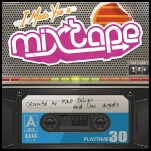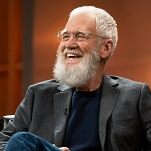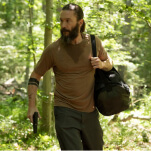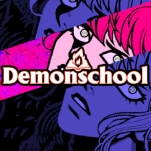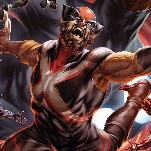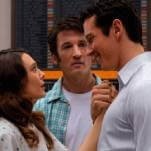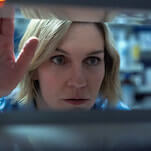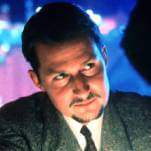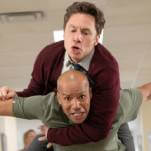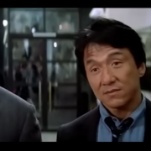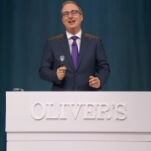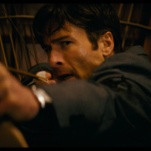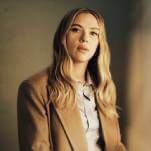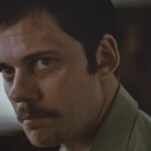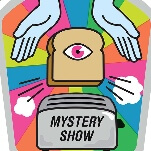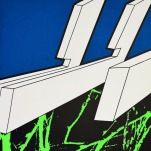Like any worthwhile filmmaker, though, the real pleasure emerges in the viewing of the films themselves. And with a major, complete retrospective of his films currently touring across North America over the next few months, now’s the perfect time to sink into Bresson.
It would be easy to sympathize with Laydu’s tortured cleric, were it not even easier to view him, wide-eyed and emaciated, as hopelessly naïve. Bresson also calculatedly stymies identification. Part of his “austere” style includes the eschewing of close-ups, one of cinema’s go-to techniques for poking the viewer into feeling compassion. Frequently, Bresson’s camera will rush forward, as if en route to a dramatic close-up, only to bleed to black at the arm’s reach of a full shot, keeping the characters’ internal worlds (and the outward expressions of them) at a remove from the viewer.
The film’s genius is that these scenes are not at all critical. Bresson even opens Pickpocket with a disclaimer warning audiences that it will not unfold in the style of classic crime caper, or policier. In knocking out the load-bearing plot elements from his narrative framework, Bresson is able to develop his own cinematic scaffolding, one that’s not beholden to theater or literature. Bresson wanted to explore how cinema could function as cinema, not filmed books or plays. Classical patterns of framing, editing, and even acting worked to obscure cinema, to create an “invisible” style that was no style at all. Bresson’s films upend the apple cart of invisibility. Before the harried editing rhythms of Godard’s Breathless (released a year later) would fashionably rejig the grammar of motion pictures, Pickpocket seems to advocate for a whole other way of making movies.
Intermediate Works
The film Bresson made before Pickpocket, 1956’s A Man Escaped is in many ways his most accessible. A Man Escaped also opens with an on-screen disclaimer, this time telling the viewer that the story—adapted from the memoirs of André Devigny, a member of the French Résistance imprisoned by the Nazis during WWII—will unfold “unadorned.” That word could describe much of Bresson’s work, but it seems especially relevant here. As with Pickpocket, Man Escaped sidesteps the normal rhythms of genre. It is and isn’t a prison-break picture. It takes the prison-break genre—popularized in France by Dumas’ The Count of Monte Cristo—and evacuates the high adventure elements. This is no Papillion or Con Air.
The film’s hero, François Leterrier’s Fontaine, isn’t even out for vengeance. But he’s committed to escape and he tasks himself to breaking out of his cell in Montluc prison with single-minded diligence. Bresson—himself a POW during WWII—brings the same attentiveness to the action, such as it is. Large portions of the film are given over to watching Leterrier as he stews in his cell, listening for approaching footsteps in the hall, carefully sharpening a spoon into a chisel, and braiding his bed sheets into rope. Though it runs just under 100 minutes, the film seems to be happening in real time. But the sense of the practical dullness of a jailbreak is enlivened by Bresson’s desire to represent it faithfully. (Devigny himself served as an on-set advisor.) In keeping with the religious themes coursing through his films, A Man Escaped suggests that freedom, like transcendence, is the result only of suffering and due diligence. Midway through the film, Leterrier tells an imprisoned priest, “God helps those who help themselves.” It’s as handy a summary of what seems to be Bresson’s personal religious philosophy as any. And as Leterrier darts, freed, into the rising mist in the film’s final shot, there is a sense that he’s been delivered not just from the prison, but into God’s good graces.
Traces of these grand measures of grace have trickled down to even the nastiest of contemporary European filmmakers. Take Lars von Trier, whose Breaking The Waves (1996) seems most indebted to Bresson. Besides an ending recalling that of A Man Escaped (albeit perhaps ironically), the film’s protagonist, Emily Watson’s long-suffering Bess, seems cut from the same cloth as the titular 13-year-old heroine of Bresson’s Mouchette (1967). As with Trier’s film, Nadine Nortier’s Mouchette leads a life singularly defined by tragedy and misfortune. Her mother is terminally ill. Her father’s a drunk. Her classmates and teacher seem to hate her. She seems to sulk through the entire movie soaking wet. It’s like five Charles Dickens novels are happening to her at once.
If there is a crucial difference between a filmmaker like Trier and Bresson, it’s that the latter doesn’t seem to be getting off on torturing his heroes (or heroines, more pointedly). Given the typical flatness he demanded of his actors, and his own stone-faced persona, it’s hard to imagine Bresson even capable of a smirk. His transcendent miserablism seems thematically closer to that of Belgians Jean-Pierre and Luc Dardenne, contemporary filmmakers who, like Bresson, seem to prefer the company of non-professional actors, and who seem concerned with themes or redemption and salvation, albeit not in Bresson’s loftier, more spiritual terms.
It’s important not to confuse Bresson’s central preoccupation with the destiny of the human soul with some kind of warm and fuzzy sentimentality, though. For all their redeeming spirituality, his films account for some of the most formative entries in cinema’s feel-bad canon. Take his last effort, 1983’s L’Argent. The film is a fusion of two unlikely ideological bedfellows: Catholicism and Marxism. L’Argent begins by following the path of a counterfeit 500 franc note, passed from a young man to a photo-shop owner to a contractor (Christian Patey) employed by the shop, who is eventually arrested when he innocently tries to pass it off at a restaurant. When the other people tied to the bogus bill establish a conspiracy of obliviousness, Patey’s lower-class worker ends up losing his job, forcing him into a life of petty criminality and, eventually, serial murder.
Like Pickpocket and Lancelot Du Lac, L’Argent is a film that is most remarkable for what it ostensibly “lacks.” Here, the unexpressive acting style that defines the bulk of the performances in Bresson’s films betrays the sociopathic urges bubbling inside Patey. And here again, the film elides its most sensational action. The film’s final murders, of a hotel clerk and a family living in a country house, are snipped out, as if they’re too unbearable to see. Bresson proves that the violence is still visible, and horrifying, even if it is off-screen. This idea, that violence’s reverberations are felt throughout the world, is much more unnerving than a juicy axe-murder sequence, which cinema already has plenty of.
L’Argent seems like the end-point of a game of one-upmanship Bresson is playing with himself, and the viewer. It’s possible to accept the salvation of humbled man of the cloth in County Priest, or a fearless French resister in A Man Escaped. Even pickpocketing’s not so bad compared with spree killing. But what about a man who commits vile crimes, both against a society that has wronged him and individual people who have not? What are the limits of compassion?
Advanced Studies
The Devil, Probably (1977) feels like the most modern of Bresson’s films. As with L’Argent, Bresson seems to connect more explicitly with real-world concerns of the moment—specifically, the existential malaise of post-’68 radicalism in France. Though it drifts through a handful of politically active young people, Devil zeroes in on Antoine Monnier’s disillusioned radical. Like Pickpocket’s titular thief, he holds himself above society, and especially his more idealistic peers. Equally contemptuous of both life and death, he sees suicide as his only reasonable option—or, in that grand absurdist tradition, so unreasonable that it’s completely in keeping with the mood of the world. In France, The Devil, Probably was considered an out-and-out incitement to suicide and banned to viewers under the age of 18. It’s a wasted-youth picture that romanticizes neither its conflicted idealists nor its resigned pessimist. Richard Hell, who would know, called it “by far the most punk film ever made.”
Bresson’s tendency to block the viewer’s sympathy with his characters—in The Devil, Probably and elsewhere—may seem mean-spirited at a glance. With the exception of some of his earlier films, the acting style is uniformly flat and unexpressive. Compare his restrained The Trial Of Joan Of Arc (1962) with Carl Theodor Dreyer’s The Passion Of Joan Of Arc (1928), a film that practically minted the use of close-ups to amp up expressivity. Bresson’s conception of spirituality is grander. He seems to want to the viewer to suffer along with his anguished protagonists, to really empathize instead of recognizing and obeying the cinematic cues that advocate for empathy. To this end, Bresson frequently obscured faces altogether. He didn’t only render them affectless, but often placed them outside of the frame, focusing instead on hands, legs, and other more instrumental body parts. This focus on the body invests Bresson’s films with a degree of earthy sensuousness that’s recognized less than their more elegant spiritualism. Bresson may have been primarily concerned with scanning for the human soul, but he got at it, more often than not, by carefully focusing on the body and its interactions with the physical world.
Au Hasard Balthazar (1966) seems to take this idea to its endpoint. Here, the soul of an animal is investigated, along with the seemingly bottomless depths of Bresson’s conception of spirituality. The film plays young Anne Wiazemsky opposite its titular mule, Balthazar. As with A Man Escaped and Mouchette, Balthazar is essentially a journey through suffering to sainthood, except this time it’s an animal as well as a girl who ends up beatified. Balthazar seems as much a precedent to mawkish talking-animal kids’ movies as Canadian director Denis Côté’s latest, Bestiaire, which traces humanity’s exploitative, often exceedingly cruel relationship with animals. Jean-Luc Godard, perhaps Bresson’s most fervent devotee, called Balthazar “the real world in an hour and a half” and went on to marry Wiazemsky, also casting her in his La Chinoise and Weekend.
Bresson’s little-screened first film, 1943’s Angels Of The Street, is instructive viewing if only because its conventionality puts the radical unconventionality of his other films into relief. The story of a young nun (Renée Faure) struggling to connect with a bitter woman incarcerated (wrongly, she says) for theft, the film uses professional actors, fairly orthodox framing and editing patterns, and even close-ups, all things that Bresson would get away from as he developed his signature style. It’s even expressive! Characters laugh and cry and everything. But the film’s emotional intensity and honesty seems consistent with his later work, as does its explicit focus on redemption and characteristically Bressonian downbeat ending.
Bresson’s second feature, Les Dames Du Bois De Boulogne (1945) is interesting as it serves as a pivot into the more lauded high watermarks of his career. With dialogue by novelist/poet/filmmaker Jean Cocteau, this lavish revenge drama was, like Angels Of The Street, decidedly more conventional. It’s also Bresson’s last film to feature a cast made up of largely professional actors, marking the period when he moved away from existent modes of filmmaking and began more deliberately refining his own aesthetic.
Miscellany
There are plenty of directors who have written explicitly about the art of cinema—Dreyer, Eisenstein, pretty much all of the French New Wave filmmakers who held down previous careers as critics. Bresson’s Notes On The Cinematographer, a slim volume published in 1975, sits atop this canon, right up there with Tarkovsky’s Sculpting In Time. In his book, Bresson lays out his conception of cinematography, which he thought was the heart of the cinema more than acting or storytelling. The text lays out his thoughts on actors (“Mechanized outwardly, Intact, virgin within”), sound design (“A locomotive’s whistle imprints in us a whole railroad station”), and editing. (“One should not use the camera as if it were a broom.”)
Half-philosophy, half-poetry, Notes On The Cinematographer echoes Bresson’s films in how simply and deliberately form and content are dovetailed. His writing style is sparse, even elliptical, and sometimes paradoxical to the point of being vexing. In one passage he states that the filmmaker must seek the “simultaneous precision and imprecision of music.” In another, he describes the “ejaculatory force” of the human eye. These pocket-sized profundities are not only highly edifying for anyone seeking to understand the complexities of Bresson’s filmmaking, they’re also kind of incidentally funny. Notes On The Cinematographer reads in places like The Art Of War for filmmakers.
The Essentials
1. Pickpocket
Perhaps the clearest expression of Bresson’s style and sensibility, his seminal anti-thriller informed the work of Paul Schrader, Martin Scorsese, and especially Jean-Luc Godard, who claimed to have seen it 10 times before shooting Breathless.
2. Diary Of A Country Priest
The link between Bresson’s more conventional early films and his more canonical work, Country Priest lays out a template for the themes the director would revisit throughout his career: religion, suffering, salvation, and the nature of grace.
3. A Man Escaped
This procedural of a French POW escaping from a Nazi-occupied prison in WWII is the most triumphant, and user-friendly, of Bresson’s masterpieces.
4. L’Argent
Showing that he wasn’t just concerned with airy stuff like the fate of the soul, Bresson’s last film is also his most explicitly social.
5. Au Hasard Balthazar
Revered by many critics as Bresson’s finest film, this tragic Christ-as-mule story pushes the limits of the filmmaker’s already generous conceptions of spirituality and sainthood.






